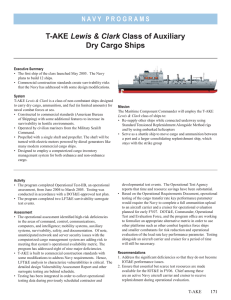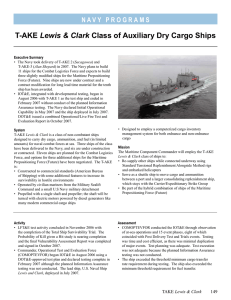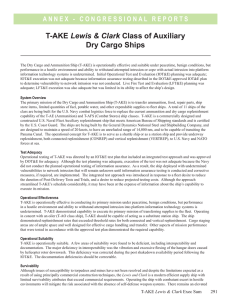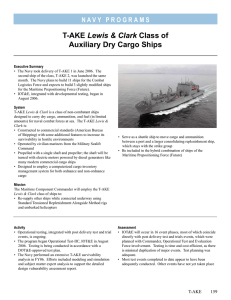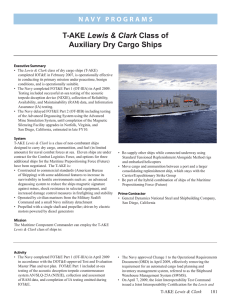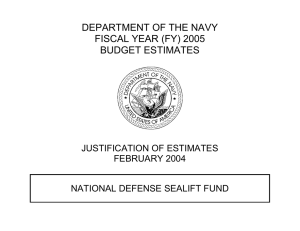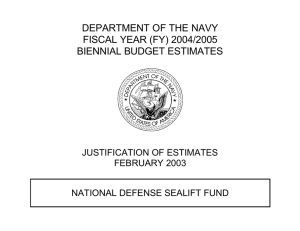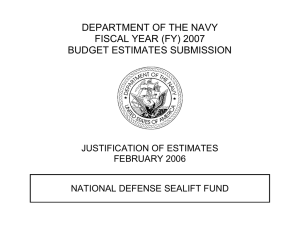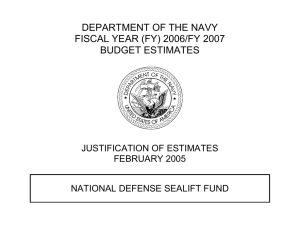T T-AKE 1 Class Dry Cargo/Ammunition Ship NAVY PROGRAMS
advertisement
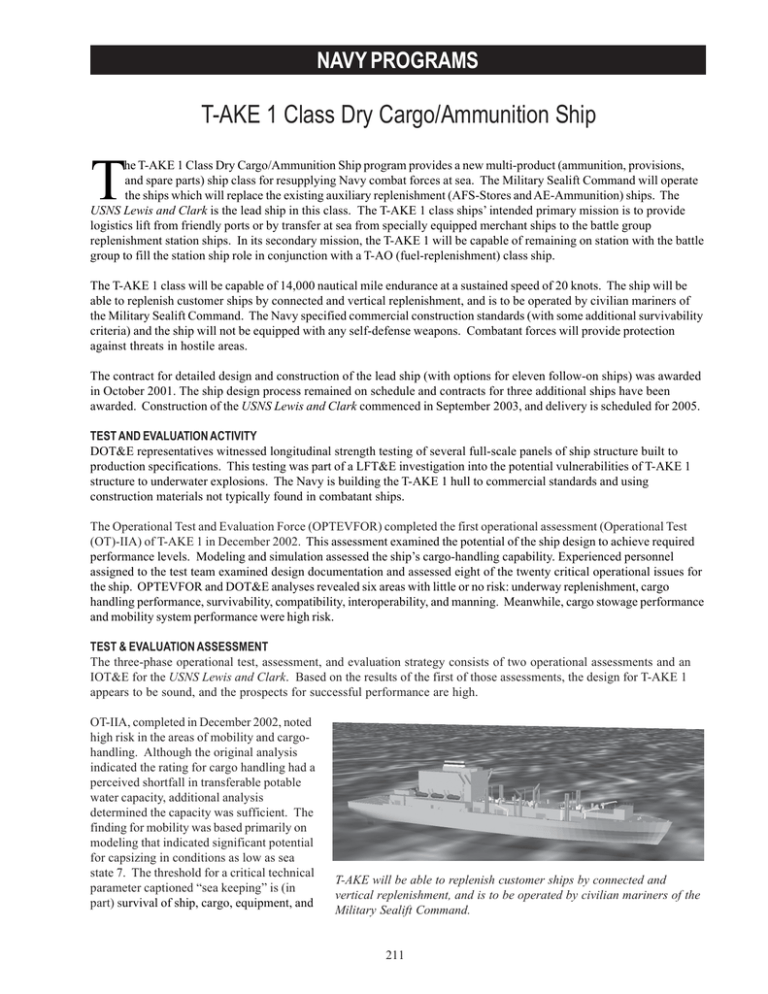
NAVY PROGRAMS T-AKE 1 Class Dry Cargo/Ammunition Ship T he T-AKE 1 Class Dry Cargo/Ammunition Ship program provides a new multi-product (ammunition, provisions, and spare parts) ship class for resupplying Navy combat forces at sea. The Military Sealift Command will operate the ships which will replace the existing auxiliary replenishment (AFS-Stores and AE-Ammunition) ships. The USNS Lewis and Clark is the lead ship in this class. The T-AKE 1 class ships’ intended primary mission is to provide logistics lift from friendly ports or by transfer at sea from specially equipped merchant ships to the battle group replenishment station ships. In its secondary mission, the T-AKE 1 will be capable of remaining on station with the battle group to fill the station ship role in conjunction with a T-AO (fuel-replenishment) class ship. The T-AKE 1 class will be capable of 14,000 nautical mile endurance at a sustained speed of 20 knots. The ship will be able to replenish customer ships by connected and vertical replenishment, and is to be operated by civilian mariners of the Military Sealift Command. The Navy specified commercial construction standards (with some additional survivability criteria) and the ship will not be equipped with any self-defense weapons. Combatant forces will provide protection against threats in hostile areas. The contract for detailed design and construction of the lead ship (with options for eleven follow-on ships) was awarded in October 2001. The ship design process remained on schedule and contracts for three additional ships have been awarded. Construction of the USNS Lewis and Clark commenced in September 2003, and delivery is scheduled for 2005. TEST AND EVALUATION ACTIVITY DOT&E representatives witnessed longitudinal strength testing of several full-scale panels of ship structure built to production specifications. This testing was part of a LFT&E investigation into the potential vulnerabilities of T-AKE 1 structure to underwater explosions. The Navy is building the T-AKE 1 hull to commercial standards and using construction materials not typically found in combatant ships. The Operational Test and Evaluation Force (OPTEVFOR) completed the first operational assessment (Operational Test (OT)-IIA) of T-AKE 1 in December 2002. This assessment examined the potential of the ship design to achieve required performance levels. Modeling and simulation assessed the ship’s cargo-handling capability. Experienced personnel assigned to the test team examined design documentation and assessed eight of the twenty critical operational issues for the ship. OPTEVFOR and DOT&E analyses revealed six areas with little or no risk: underway replenishment, cargo handling performance, survivability, compatibility, interoperability, and manning. Meanwhile, cargo stowage performance and mobility system performance were high risk. TEST & EVALUATION ASSESSMENT The three-phase operational test, assessment, and evaluation strategy consists of two operational assessments and an IOT&E for the USNS Lewis and Clark. Based on the results of the first of those assessments, the design for T-AKE 1 appears to be sound, and the prospects for successful performance are high. OT-IIA, completed in December 2002, noted high risk in the areas of mobility and cargohandling. Although the original analysis indicated the rating for cargo handling had a perceived shortfall in transferable potable water capacity, additional analysis determined the capacity was sufficient. The finding for mobility was based primarily on modeling that indicated significant potential for capsizing in conditions as low as sea state 7. The threshold for a critical technical parameter captioned “sea keeping” is (in part) survival of ship, cargo, equipment, and T-AKE will be able to replenish customer ships by connected and vertical replenishment, and is to be operated by civilian mariners of the Military Sealift Command. 211 NAVY PROGRAMS personnel in sea state 9, all headings, zero speed. This is an unachievable goal for a T-AKE 1-size ship. It was apparently set as a result of modeling findings that simulated only a subset of the important capsizing mechanisms. The critical technical parameter has been modified to require survival in see state 8 (significant wave height up to 60 feet) when the ship has propulsion power to maintain a favorable heading into the seas. The modeling conducted to support the operational assessment indicates that T-AKE 1 should achieve this level of performance. In LFT&E, the longitudinal strength testing and the analysis of the test results will continue into FY04. Preliminary results indicate the existing analytical tools used to predict the strength of the hull and the ship’s response to underwater explosion loading can be used reliably in the vulnerability assessment of T-AKE 1. Other events in the LFT&E surrogate test program are behind schedule due to over-commitment of test resource. This may contribute to a delay in completing the Detail Design Vulnerability Assessment Report and, with four ships already under contract, may reduce the likelihood that any deficiencies identified in the assessment will be corrected in the ship design. 212
